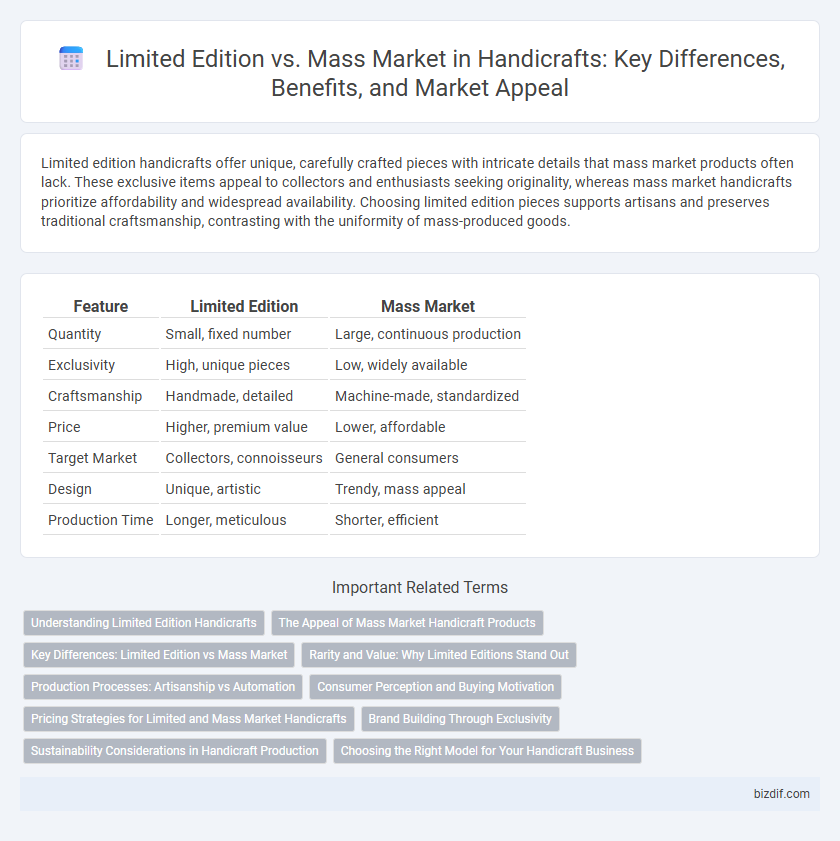Limited edition handicrafts offer unique, carefully crafted pieces with intricate details that mass market products often lack. These exclusive items appeal to collectors and enthusiasts seeking originality, whereas mass market handicrafts prioritize affordability and widespread availability. Choosing limited edition pieces supports artisans and preserves traditional craftsmanship, contrasting with the uniformity of mass-produced goods.
Table of Comparison
| Feature | Limited Edition | Mass Market |
|---|---|---|
| Quantity | Small, fixed number | Large, continuous production |
| Exclusivity | High, unique pieces | Low, widely available |
| Craftsmanship | Handmade, detailed | Machine-made, standardized |
| Price | Higher, premium value | Lower, affordable |
| Target Market | Collectors, connoisseurs | General consumers |
| Design | Unique, artistic | Trendy, mass appeal |
| Production Time | Longer, meticulous | Shorter, efficient |
Understanding Limited Edition Handicrafts
Limited edition handicrafts are meticulously crafted in restricted quantities to enhance exclusivity and value, often showcasing superior artistry and rare materials. These pieces appeal to collectors and connoisseurs who prioritize uniqueness and authenticity over mass-produced items. The limited production not only preserves traditional techniques but also drives demand by emphasizing scarcity in the handicraft market.
The Appeal of Mass Market Handicraft Products
Mass market handicraft products attract consumers through their affordability and wide availability, making unique designs accessible to broader audiences. These items benefit from efficient production techniques that maintain the essence of traditional craftsmanship while meeting high demand. Accessibility and consistent quality contribute to their strong appeal in global markets.
Key Differences: Limited Edition vs Mass Market
Limited edition handicrafts emphasize exclusivity and unique craftsmanship, featuring a restricted production run that enhances their collectible value and artistic appeal. Mass market handicrafts prioritize large-scale production with affordable pricing and consistent quality to meet widespread consumer demand. The key differences lie in production volume, item uniqueness, pricing strategy, and target audience.
Rarity and Value: Why Limited Editions Stand Out
Limited edition handicrafts are distinguished by their rarity, as only a finite number of pieces are produced, enhancing their exclusivity and desirability among collectors. This scarcity directly increases the perceived value and often results in higher market prices compared to mass-market products, which are widely available and lack uniqueness. The craftsmanship and authenticity in limited editions further contribute to their distinction, making them prized possessions that retain or appreciate in value over time.
Production Processes: Artisanship vs Automation
Limited edition handicrafts emphasize artisanship, with skilled craftsmen using traditional techniques to create unique, carefully detailed pieces in small quantities. Mass market production relies heavily on automation and standardized processes to manufacture large volumes quickly and cost-effectively, sacrificing individuality for consistency. The contrast between handmade precision and machine efficiency defines the distinct production processes of limited edition versus mass-produced handicrafts.
Consumer Perception and Buying Motivation
Limited edition handicrafts are perceived as unique, exclusive, and high-value items, driving consumer motivation through the allure of scarcity and personal identity expression. Mass market handicrafts appeal to buyers seeking affordability, accessibility, and consistent availability, prioritizing practicality and wide acceptance. Consumer perception often associates limited editions with superior craftsmanship and emotional connection, while mass market products emphasize convenience and trend conformity.
Pricing Strategies for Limited and Mass Market Handicrafts
Pricing strategies for limited edition handicrafts emphasize exclusivity and craftsmanship, often commanding premium prices due to scarce availability and unique designs. Mass market handicrafts utilize competitive pricing and economies of scale to appeal to a broader consumer base, prioritizing affordability and volume sales. Understanding price elasticity and target demographics is essential to balancing profitability and market reach in both segments.
Brand Building Through Exclusivity
Limited edition handicrafts create a strong brand identity by emphasizing uniqueness and scarcity, attracting collectors and discerning buyers who seek originality. This exclusivity enhances perceived value and fosters customer loyalty, setting the brand apart from mass market products that cater to broad, less personalized demand. By prioritizing limited runs, artisans can build a prestigious reputation focused on quality and authenticity rather than volume.
Sustainability Considerations in Handicraft Production
Limited edition handicrafts emphasize sustainability by using locally sourced, eco-friendly materials and traditional techniques that minimize waste and environmental impact. Mass market production often relies on synthetic materials and large-scale manufacturing processes that contribute to resource depletion and pollution. Choosing limited edition crafts supports ethical practices, preserves cultural heritage, and reduces the carbon footprint associated with mass-produced goods.
Choosing the Right Model for Your Handicraft Business
Choosing the right model for your handicraft business hinges on balancing exclusivity and scalability, where limited edition products enhance brand prestige and create urgency, while mass market items maximize reach and consistent revenue. Limited editions showcase artisan skills and uniqueness, attracting collectors and niche markets, whereas mass market models benefit from economies of scale and broader customer bases. Evaluating target audience preferences, production capacity, and marketing goals is essential to align your business strategy with market demand and profitability.
Limited Edition vs Mass Market Infographic

 bizdif.com
bizdif.com